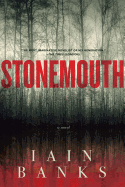
Scotsman Iain Banks published his first novel, The Wasp Factory, in 1984. It received much critical attention, good and bad. His portrait of Frank, a teenage serial killer of members of his own family, was famously described by the Irish Times as a work of "unparalleled depravity." Banks has gone on to a prolific career writing fiction as Iain Banks and writing science fiction as Iain M. Banks.
Stonemouth opens with narrator Stu Gilmour, the "exile," standing in the rain on a bridge on Stoun Firth, Scotland, that's famous for suicides. It leads into the town he left five years ago, for what he terms "my sins." He reflects on his class's first suicide, Callum, who jumped from this bridge (or did he?). Stu reflects as well on "clarity"--that "would have been good." But clarity about what?
We follow Stu over the course of a long weekend. Old Murston, of a local crime family, has died and Stu is there, uninvited, for the funeral. He reacquaints himself with old friends and with his old love, Ellie Murston, who still lives in the small town, and reflects over and over on his youthful past. It's been five years, and nothing seems to have changed, except Stu. Another death occurs later, a result of what is and isn't right in Stonemouth and in Scotland, and what never may be right. Banks has fashioned a dark, deep and subtle study of a young man trying to come to grips with himself. --Tom Lavoie, former publisher

